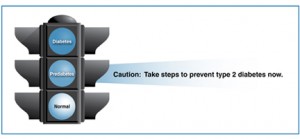 People with prediabetes have blood glucose levels that are higher than normal but not high enough for a diagnosis of diabetes. This condition raises the risk of developing type 2 diabetes, heart disease, and stroke.
People with prediabetes have blood glucose levels that are higher than normal but not high enough for a diagnosis of diabetes. This condition raises the risk of developing type 2 diabetes, heart disease, and stroke.
Prediabetes is also called impaired fasting glucose (IFG) or impaired glucose tolerance (IGT), depending on the test used to diagnose it. Some people have both IFG and IGT.
IFG is a condition in which the blood glucose level is high—100 to 125 mg/dL—after an overnight fast, but is not high enough to be classified as diabetes. The former definition of IFG was 110 mg/dL to 125 mg/dL.
IGT is a condition in which the blood glucose level is high—140 to 199 mg/dL—after a 2-hour OGTT, but is not high enough to be classified as diabetes.
Prediabetes is becoming more common in the United States. The U.S. Department of Health and Human Services estimates that at least 57 million U.S. adults ages 20 or older had prediabetes in 2007. Those with prediabetes are likely to develop type 2 diabetes within 10 years, unless they take steps to prevent or delay diabetes.
The good news is that people with prediabetes can do a lot to prevent or delay diabetes. Studies have clearly shown that people can lower their risk of developing diabetes by losing 5 to 7 percent of their body weight through diet and increased physical activity. A major study of more than 3,000 people with IGT found that diet and exercise resulting in a 5 to 7 percent weight loss—about 10 to 14 pounds in a person who weighs 200 pounds—lowered the incidence of type 2 diabetes by nearly 60 percent. Study participants lost weight by cutting fat and calories in their diet and by exercising—most chose walking—at least 30 minutes a day, 5 days a week.
via Diabetes Overview – National Diabetes Information Clearinghouse.









